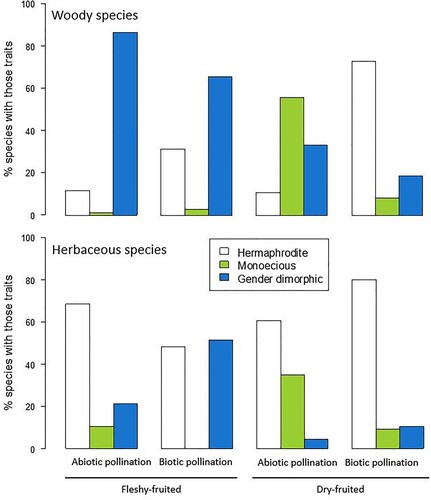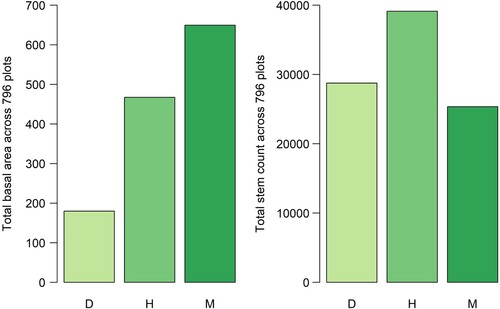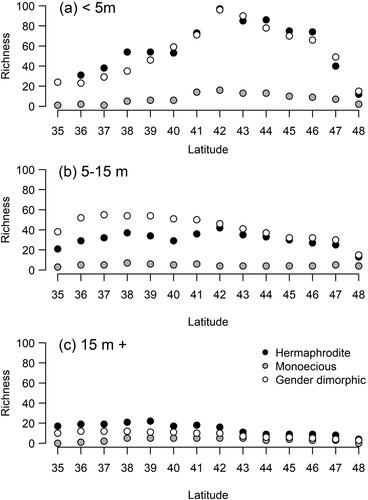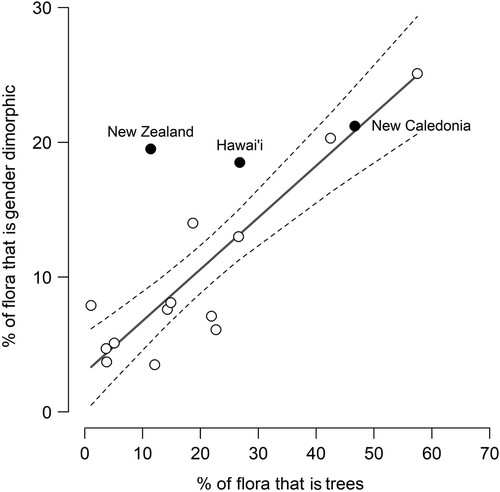Figures & data
Table 1. Angiosperm sexual systems found in New Zealand angiosperms.
Table 2. Life form classification for the New Zealand angiosperm flora (n = 2080 taxa) with the number of species of each gender in each lifeform.
Table 3. Traits of New Zealand angiosperm genera with solely cosexual species or with at least one gender dimorphic species.
Table 4. Distribution of plant sexual systems within traits and trait combinations in the New Zealand angiosperm flora.
Table 5. Gender dimorphism (dioecious + gynodioecious species) in the New Zealand angiosperm flora according to pairs of life history traits.
Figure 1. Frequency of the three major plant sexual systems within species that share combinations of woodiness, pollination mode, and possession of fleshy or dry fruits.

Table 6. Flower size (corolla diameter) in New Zealand biotically pollinated angiosperms (excluding Asteraceae and excluding abiotically pollinated species).
Table 7. Flower colour and sexual system in New Zealand biotically pollinated angiosperms (including Asteraceae and excluding abiotically pollinated species).
Figure 3. Total basal area (m2) and stem count for all tree species sampled across 796 forest plots throughout New Zealand. D = gender dimorphic (n = 84 species sampled); H = hermaphrodite (n = 82 species sampled); M = monoecious (n = 12 species sampled).

Figure 4. Range sizes of New Zealand tree species, plotted by sexual system. Range size is the total number of 1° latitudinal bands where a species naturally occurs. Fitted linear models with 95% confidence intervals are shown for each sexual system.

Figure 5. Richness of New Zealand tree species in latitudinal bands by height class and sexual system.

Table 8. Genera in which it is probable that gender dimorphism evolved autochthonously in New Zealand.
Table 9. Incidence of the three major plant sexual systems in a selection of global angiosperm floras.
Figure 6. Key examples of sexual systems in New Zealand angiosperms. A, Myrsine salicina (Myrsinaceae). Gender dimorphism is rich among fleshy-fruited, subcanopy tree species. B, Aciphylla colensoi (Apiaceae). Gender dimorphism in herbaceous species is strongly concentrated in two genera, namely Aciphylla and Astelia. C, Astelia fragrans (Asteliaceae). D, Fuscospora cliffortioides (Nothofagaceae). Monoecy is uncommon in New Zealand woody plants, but is found in the five species of Nothofagaceae that dominate forest structure (48.4% of basal area nationally). E, Ascarina lucida (Chloranthaceae) is a rare example of a small monoecious tree. F, Carex decurtata (Cyperaceae). Monoecy is found in just 296 species but 66.7% of those are species of Carex. G, Pterophylla racemosa (Cunoniaceae) and H, Beilschmiedia tawa (Lauraceae). Tall and dominant forest species tend to be cosexual, and these two species contribute 20% of basal area nationally.

Figure 7. Percent gender dimorphism in the flora versus percent tree species in the flora, for 16 floras. The three Pacific archipelagos with high gender dimorphism (New Zealand, New Caledonia, and Hawai'i) are shown. Fitted linear model with 95% confidence intervals excludes New Zealand because it is an apparent outlier (%) flora ∼ 2.91 + (0.384 × % trees); F1,13 = 57.1, P < 0.0001, adjusted R2 = 0.84. Data and data sources are provided in .

Supplemental tables
Download MS Word (39.3 KB)Data availability
A full copy of the data are available from the Manaaki Whenua – Landcare Research Datastore website: https://doi.org/10.7931/qzf7-9q70.

